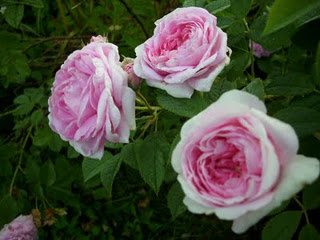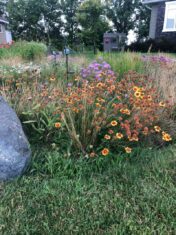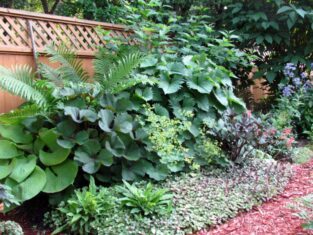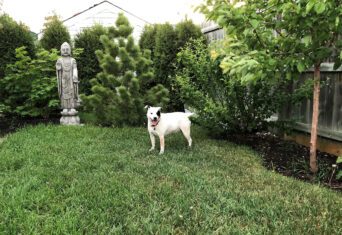I’ve been lurking around mail-order rose websites (hortico.com, pickeringnurseries.com, palatineroses.com, cornhillnursery.com), because it’s time to plan my annual order of bare-root shrubs. Ordering from rose nurseries is a way to find roses on their own roots, which are often stronger plants. Although I’m drawn to the potted roses in leaf sold at garden centres, more often than not I break some of their foliage in the car, and then shatter the root ball during planting. So it seems I’m not gaining much by purchasing roses that way. Ordering by mail gives me a larger selection, and they can be held in the cold garage for a few days, even if they’re bare-root. They’re much easier to handle and plant when there’s no root ball to worry about, and they usually arrive with red buds ready to sprout. (Sometimes they’ve actually sprouted, and it’s okay if those fresh little stems break off, the plant will quickly make new ones.)

You might remember that I was driven to distraction by Japanese beetles on my roses in recent summers. I’ve devised a workable plan, and that is to plant those that bloom once for an extended period in early summer, which is before the beetles begin to feed. So far I have two in the garden: ‘Etna’, a perfumed crimson moss rose blooming in June; and ‘Canary Bird’, a species hybrid that comes into bloom in mid-May. I’m after another couple of moss roses, because their pungently scented mossy hairs (actually scent glands) on the stems and buds are an added feature before the flowers bloom. I found a Kordes rose, ‘Black Boy’ (Zone 5), with deep purple-red petals flushed with black, deeply perfumed and disease resistant. It was grown at the Montreal Botanical Garden where it was selected as strongly resistant to blackspot, mildew and rust diseases.
Then I came across ‘Rene d’Anjou’ (Zone 6), an old French rose bred in 1853, with globular blooms deeper pink in the centres and silvery pink outside guard petals. It’s highly scented, disease resistant, and like other old roses, tolerates less than perfect soil. Both ‘Black Boy’ and ‘Rene d’Anjou’ have double petals, grow four to five feet (1.2 to 1.5 m) tall and about 40 inches (1 m) wide, manageable sizes for a small front garden. These once-blooming roses are going to be a pleasure to grow and are on the order list.
Then I fell into the perpetual trap of desiring a rose I really shouldn’t consider, a beautiful rose that blooms through the summer, when Japanese beetles are feeding. It’s another Kordes introduction, ‘Rugelda’, a hybrid rugosa shrub with fully double yellow flowers and crimson-touched petal edges. It’s not one of those egg-yolky yellows (like ‘Chinatown’), but has a clear lemon centre and the whole blossom fades to creamy butter as it ages. What style! The crimson petal edges are sporadic and the flower doesn’t appear painted (like ‘Double Delight’). Have I offended anyone’s favourite rose? Hope not. And oh my goodness, the ‘Rugelda’ flower bud is totally gorgeous, a classic hybrid tea-style bud, with yellow petals still furled and boldly flushed with crimson.
Well, I’m a fool for a good yellow rose, even if it’s going to be lunch and dinner for the Japanese beetles. It goes on the list, and if I get totally desperate with the beetle activity, I’ll put a net over the shrub. Rose lust is often the mother of invention.









Hi Joy (Jan 26),
Thanks for reminding me about J.P. Connell. I haven’t seen one recently, but will put it on my list. I remember it as tall and slender, with a sophisticated bud. Wish I looked like that!
— Judith
Judith this is a great article because many of us suffer “rose lust” especially this time of year. I am a big fan of Hortico because it allows you to order “one” rose instead of the mainstay of three for many of the mail order companies … and they charge a higher shipping fee while Hortico is the best price going . I am addicted to climbers right now for height and scent that will waft through my garden .. Zephirine Drouhin (which is one I already have but have ordered another one) to be paired with Ilse Krohn Superior .. yes, I too worry about the beetle problem but I am taking my chances because I am in full rose mode ? .. You might want to look at JP Connell with it’s soft buttery yellow rose .. it is beautiful and very hardy .. if you are a yellow fan I recommend it highly ! Good idea about the net for shrub roses .. I might take that suggestion too ! Thanks
Joy